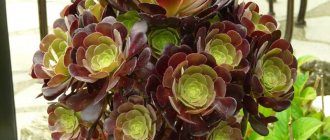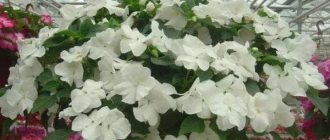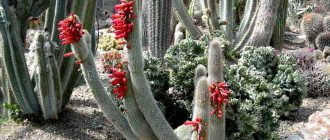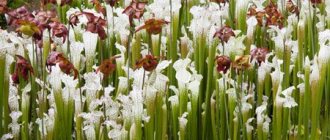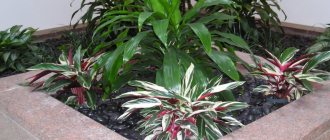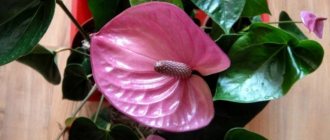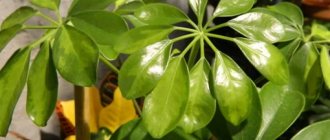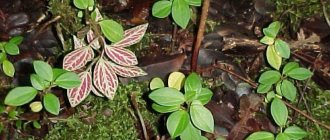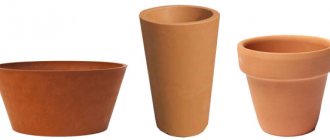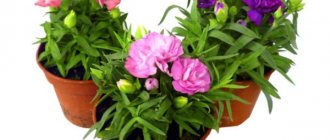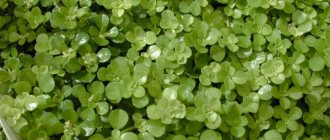Loading…
Loading…
The flora of tropical rainforests is so rich and diverse that it still presents botanists with surprises and reasons for serious scientific discoveries. The genus Alocasia includes several dozen species, the exact number of which would be difficult for even a specialist in tropical flora to name.
And it’s not just the inaccessibility of the islands of Oceania or the dense jungles that hide unstudied specimens. The nature of the region is incredibly generous and creates all the conditions for natural hybridization and the emergence of ever new varieties of alocasia.
In addition, plants arriving in Europe, the USA, Russia and other countries invariably arouse the interest of flower growers, who develop new, previously unseen varieties and hybrids. Today, indoor plant lovers have at their disposal specimens with green, variegated and even purple foliage in the shape of a trefoil, like the alocasia in the photo. Look at the photo of the saxifrage!
Alocasia Corazon
From the humid tropics and subtropics of southern Asia and Australia, a spectacular but very small indoor alocasia came to Europe, as in the photo, not exceeding 40–55 cm in height. The variety was developed as a result of painstaking selection work, and several wild species became the parent forms.
The leaves, the main wealth of Alocasia Corazon, are smooth, green, with a grayish metallic sheen. Against the background of a rather light leaf plate, dark veins are clearly visible. The length of the leaf of this variety of alocasia, as in the photo, reaches 20 cm, the width of the plate is half that.
Alocasia Corazon is very attractive, but to bring out the best traits of the plant, it requires fairly bright but not direct light, plenty of watering and careful care, especially aimed at controlling pests. The crop can be affected by spider mites, which quickly invade the cuttings and the back of the leaves.
Unfortunately, today you can rarely find this variety on windowsills. although it is no less interesting than well-known varieties, for example, Alocasia Black Corduroy or the hybrid Alocasia Amazonica Polly.
Diseases and pests
Since alocasia is poisonous, it is rarely attacked by insect pests and is resistant to various diseases. However, if the conditions of care and maintenance are violated, the plant can be attacked by aphids, spider mites, mealybugs, thrips and scale insects.
When a spider mite attacks, thin white cobwebs appear on the underside of the leaf. They fight the pest by spraying the affected areas with a weak tobacco infusion, and sprinkle the places where the cobwebs appear with ground sulfur.
With the appearance of the scale insect, dark spots appear on the plant. They fight it by spraying with a soap-tobacco solution with the addition of kerosene or denatured alcohol.
When aphids appear, the leaves lose their decorative appearance, dry out, and become deformed. The pest settles on the underside of the leaf, feeds on its sap, and multiplies quickly. To kill aphids, spray a solution of nicotine sulfate with soap in a ratio of 1 gram of powder per 1 liter of soapy water.
Alocasia pests mainly appear due to low humidity and high air temperatures and stagnant moisture in the soil.
Pest control begins at the first signs of damage; leaf blades are wiped on all sides with a soap solution, powdered with ground sulfur; in advanced cases, broad-spectrum insecticides are used, for example, Actellik.
After treatment, a day later, the plant must be rinsed well in the shower, after covering the soil with film. If insect pests are detected, the treatment is repeated again.
Due to waterlogging of the soil, stagnation of water and too dense soil, the plant becomes ill with a fungal disease - root rot. For control, fungicides (Topsin, Fundazol) are used, the flower is transplanted into new loose soil, and the affected and rotten parts are removed. The formation of brown spots on the leaves of alocasia indicates a powdery mildew disease: in this case, the plant is treated with copper-containing preparations (Oxychoma, Polycarbacin). To prevent alocasia disease, the flower is sprayed with a soap solution and treated with colloidal sulfur.
Alocasia Polly
Alocasia Polly, shown in the photo, is the smallest representative of plants, thanks to the shape of its leaves, which have earned the name “African mask”. The height of an adult plant does not exceed 50–65 cm, which allows the plant to find a place even in a small room. The only condition for good growth is sufficient moisture, light and heat. With proper care, Alocasia Amazonica Polly is grown as a perennial crop, and this variety is easier than others to tolerate the lack of light that is inevitable in the autumn-winter period.
Dark, pointed foliage with contrasting veins can be compared to the shield of an ancient warrior or, as in the photo of alocasia, to a trefoil.
By its nature, Alocasia Polly is a dwarf variety of Alocasia Amazonica, obtained through crossing wild plants in the middle of the last century. The Alocasia Polly itself, shown in the photo, was first grown just two decades ago and in such a short time won the love of flower growers all over the world.
How to propagate
Reproduction of alocasia at home is possible:
- seeds;
- tubers;
- cuttings;
- dividing the rhizome.
The best time for breeding is spring. The movement of sap in plants increases, and this will contribute to the rapid growth of the root system.
Propagation by seeds is a rather labor-intensive method, and the seeds themselves are very difficult to obtain, since the species rarely bloom at home, and industrial seeds may not be available for sale. But, if you are lucky enough to get hold of seeds, then they are planted using this method:
- Nutritious and loose soil is poured into small containers and lightly irrigated with warm, soft water.
- The seeds are laid out on the surface and covered with transparent glass.
- As the seeds germinate, the glass is removed and the soil moisture is monitored.
- Grown seedlings are planted in separate cups.
When grown by seeds, the variety may turn out different from the mother bush, since 2 copies are involved in pollination.
Propagation by tubers is a fairly easy method, since they appear next to the mother flower and during transplantation they are simply planted in a small container with a nutrient substrate, and they are cared for in the same way as the mother flower.
You can propagate by cuttings, but for roots to appear, you will need to use root mass formation stimulants.
Rhizome division is carried out only in old bushes, where there are various growth points. Division is carried out in such a way that each part has both roots and a vegetative part.
Alocasia Dragon
The variety of alocasia Dragon Skin, popular among gardeners, as in the photo, attracts attention with the unusual texture of the foliage, which really resembles the scales or leathery wings of a fairy-tale monster.
The height of the plant is small and does not exceed 0.6–1 meters. The homeland of the wild ancestor of Alocasia Dragon is the tropics of Indonesia, where Alocasia copper has mastered the wet undergrowth. In apartments, it is also necessary to create suitable conditions for plants, which include abundant but dim light, regular watering and good nutrition. With proper care, as in the photo, Dragon scale alocasia will delight the gardener for a long time.
The main decoration of the flower is the extremely large and beautiful foliage, which makes the plant unforgettable and gives it an exotic look. Alocasia rhizomes are elongated and succulent. The petioles of the leaves are light green, bending under the weight of the leaf blades, which over time leads to the formation of a real “dragon skin”.
Young foliage is often green, but as it grows, as in the photo of Alocasia Dragon, darker and silvery tones appear, giving the leaves of the plant a leathery appearance. This is an ideal plant for original stylish interiors and winter gardens. In order for alocasia to remain attractive for a long time, it is protected from bright light, which can burn decorative foliage.
Alocasia Loco
A photo of this indoor alocasia invariably causes surprise and delight among home gardening lovers. Small in size, with a glossy sheen and a very sharp tip, the foliage of this variety of alocasia, as in the photo, has the shape of a pronounced trefoil, and leaves the feeling that it is made of metal or plastic. Such an amazing plant will be a great addition to tangerines, ficuses and other flowers growing at home.
The veins on the leaf blades are white, with a blurred outline. The back of the leaves has a purple or violet tint. The edge of the leaf blade is not only figuratively cut, but also corrugated, which only adds decorativeness to the unusual culture. A plant up to 50 cm high, worthy of being in the collection of a gardener who is passionate about tropical species!
Home care
Large species love space and look best in large rooms, near artificial ponds and fountains. Compact types are located near beds, in the kitchen and in the living rooms. The only thing is that this species does not tolerate drafts and close proximity to working central heating radiators. Caring for alocasia is simple and some nuances in maintaining the perennial should not cause difficulties.
How to care for alocasia so that the foliage and decorative appearance of the flower does not suffer? Mainly, it is necessary to create conditions as close as possible to natural ones, then caring for the perennial will be simple. The plant can become not only an exotic decoration for the home, but also serve as a barometer, predicting a high probability of precipitation, so the appearance of water drops on the leaves indicates impending rain.
Watering
The moisture-loving houseplant Alocasia loves moist soil. In the summer, watering should be regular - once every 2 days, the earthen ball should not dry out. Use distilled or soft, settled water; the soil in the pot must be constantly moist; if water accumulates at the bottom of the pan, it should be removed immediately. In winter, watering is reduced. When watering, you should find a “golden” mean: you can’t help but add water, but it’s also dangerous to fill the pot, since this can cause rotting of the roots.
Air humidity
Originally from the tropics, alocasia prefers high air humidity. To maintain a healthy appearance in the summer, the leaves of the plant are sprayed, the pot with the flower is placed on a tray with wet pebbles or expanded clay, but care should be taken that the pot does not stand in water, otherwise the roots may rot. In the cold season, when the central heating system is turned on, the pot with the indoor alocasia plant is placed away from the radiators, and air humidifiers are used to create additional humidity. It is useful to regularly wipe the leaves with a damp cloth or sponge.
Lighting
The tropical plant prefers bright light, but in summer it is better to shade the plant or remove it from direct sunlight. In winter, some species need special care; the alocasia flower (especially varieties of copper-red, Amazonian alocasia, Polly) should be provided with additional lighting.
Species and varieties with monochromatic leaf colors are more tolerant of lack of lighting; variegated ones require additional lighting.
Temperature
Temperature changes can cause deterioration and even death of the plant. In summer, the optimal room temperature is about +20°C, in winter it is not lower than +18°C. The flower should be protected from drafts.
Top dressing
Caring for alocasia at home requires the application of complex mineral fertilizer for indoor plants. In the spring and summer, this is done every 14-20 days. Potash fertilizers are most suitable for tropical perennials. During flowering, feed twice a month with complex fertilizer with a high nitrogen content. If the nitrogen content in the soil is insufficient, plant growth slows down and alocasia diseases may occur. In winter, the flower is fed once a month.
The soil
The soil for alocasia should be nutritious, medium density, loose, with good permeability to moisture and air, a substrate with a slightly acidic reaction. Prepare the soil for the plant: leaf, coniferous, peat soil (1 part each) and ½ part sand.
Possible difficulties
The perennial alocasia is a fairly unpretentious plant, but some problems may arise when grown at home. This is mainly due to errors in the maintenance of the flower. Insufficient watering can provoke the proliferation of spider mites. Fading leaves can be a signal of both excessive and insufficient watering; the watering regime should be reconsidered or the soil should be replaced with a lighter and looser one. If the leaves begin to cry, you should reduce spraying and watering.
Slowing or stopping the growth of the plant indicates a lack of nitrogen in the soil; to solve the problem, the flower is fed with a urea solution at the rate of 1 gram per liter of water. If the leaf plates are too small, the flower experiences a lack of nutrients; fertilizing should be applied.
If the tips of the leaves begin to dry out, this indicates an insufficient level of air humidity; the roots are experiencing a lack of water.
How to save alocasia if it loses its bright color, which indicates insufficient lighting? In this case, the flower pot should be moved to a more illuminated place. If natural light is not enough, additional artificial lighting is used.
The appearance of dark spots on the leaf plate indicates frequent temperature changes and the presence of drafts.
When a perennial begins to lose leaves, check the rhizome for rot. If there is no damage to the underground part, the flower is transplanted into new soil. Alocasia is artificially put into a “dormant” mode, the flower pot is left in a cool, dry room, and when new shoots form, the pot is returned to conditions comfortable for the flower.
Alocasia Bambino Arrow
The small alocasia Bambino Arrow is a variety of the hybrid species Amazonica, well known to gardeners. Plants with sharp arrow-shaped leaves in indoor conditions can grow up to 40–60 cm; some dwarf varieties are limited in development at the level of 30–40 cm.
Indoor alocasia, as in the photo, in the summer months the variety is grown at temperatures from 22 to 25 °C. In winter, when the perennial evergreen plant requires relative rest, cooling the air to 18–20 °C will not cause damage to alocasia.
The leaves of this variety of alocasia, as in the photo, have a dark color, on which wide white veins look impressive. Leaf petioles are erect.
For good growth and development of Alocasia Bambino Arrow requires well-drained, light soil, adequate nutrition and abundant watering. The plant is replanted after a year. It is best to carry out the procedure in the spring, at the beginning of the growing season.
Planting and propagation
At home, alocasia can be propagated in the following ways: cuttings, dividing the bush and planting seeds. Planting is done only in spring in fertilized loose soil. Choose deep flower pots with drainage holes at the bottom. The pot is filled to 2-3 cm with drainage material, then the soil is filled.
Transfer
Young plants are replanted every year in the spring, adult plants once every 2-3 years. It is necessary to provide a good drainage layer for better removal of excess water. For adult alocasia, transplantation is carried out using the transshipment method. If you plan to divide the bush, then the rhizome is freed from the earthen coma. Choose a new flower pot that is taller than the previous one and larger in diameter. The need to replant a flower is signaled by roots protruding from the drainage holes of the flower pot. In this case, the roots completely fill the entire space of the container, and the plant becomes cramped in it.
Reproduction methods
There are several ways to propagate alocasia: by seeds, by dividing the rhizome (sprouts or daughter tubers), and by stem cuttings.
Propagation of alocasia by seed has a characteristic feature - the variegated leaf characteristics of the plant are not transmitted. This should be taken into account when propagating species with variegated leaf blades. In this way, only alocasia with single-color foliage can be propagated.
Seeds are sown in spring in seedling containers with loose soil (peat, leaf soil and sand). During storage, seeds lose their viability due to loss of moisture, which is why sowing is carried out immediately after collection. Deepen it 0.5-1 cm into the soil, moisten it and cover the container with a transparent material (glass, polyethylene) to create a greenhouse effect. Boxes with soil should be located in a bright room at a temperature of +22...+25°C. The soil should be kept moist and constantly sprayed. After emergence, after 2-3 weeks, the cover is removed. The seedlings peak when 2-3 leaves form and are transplanted into individual small containers up to 7-10 cm in diameter. The next transplant is carried out only after the flower pot is completely filled with horses. The method requires patience, since only after 1 year large leaves appear on the young plant.
When propagating by stem cuttings, in the spring, cut off a leaf with a small fragment of stem pulp at an angle of 45°. The cut area is sprinkled with charcoal and left for 2-3 hours. To accelerate the development of the root system, Kornevin is used: the cutting is immersed in this biostimulator for a couple of hours, then planted in a separate flower pot with a sand-peat mixture. By the end of the first month, the cuttings will take root, which will be signaled by the beginning of the formation of new leaves. In the case of propagation of alocasia by offspring or daughter tubers, it is much easier to obtain a new young plant. Sprouted nodules are replanted when at least one leaf sprouts and opens.
The division of the rhizome is carried out during the transplantation process. To do this, remove the plant from the pot and free the roots from the ground. If this is difficult to do, they are lowered into water. The bush is cut into several parts with a knife so that each plot contains one or more leaf rosettes or a growth bud. All cuts are treated with charcoal. After the plots are planted in individual flower pots. The room temperature should not be lower than +23°C; it is necessary to ensure regular spraying of new plants until the leaves on the sprouts become elastic.
Alocasia macrorrhiza Lutea
The name of the alocasia variety presented in the photo Lutea is translated from Latin as “yellow,” which fully reflects the main feature of the plant. The succulent thick leaf cuttings, parts of the stem and even the veins on the leaves have a distinct yellow tint. This gives the large alocasia additional attractiveness and sets it apart from similar species and varieties.
The plant has large, wavy leaves of bright green color. The leaf blade, native to the forests of New Guinea, reaches 60 cm in length, and the alocasia itself grows up to one and a half meters. Such size and shape of foliage fully justify the popular name of this type of plant - elephant ears.
Alocasia Black Corduroy
The velvety leaves of Alocasia Black Velvet, at the first glance at the plant, amaze the imagination of everyone who is interested in indoor floriculture. The upper side of the leaf blade of this variety is distinguished not only by its unusual texture for alocasia, but also by its rich, almost black tint, which gives the plant its name.
The thick white veins are clearly visible against the velvet background. The stems are also light, erect or slightly bending. In indoor conditions, alocasia grows up to 30–45 cm in height, which makes the culture very attractive to most gardeners.
This exotic plant can become a unique interior decoration and create a corner of tropical Asia and Oceania in a city apartment.
True, at the same time, Black Velvet alocasia, as in the photo, requires the same conditions that surrounded it in its homeland. This means that air humidity and temperature are important to the plant. For health and good appearance, alocasia needs nutritious, loose soil and abundant regular watering. If care is neglected, alocasia quickly loses its attractiveness; its large oval leaves lose their velvety quality, become thinner and become covered with painful spots.
In the Alocasia Black Velvet shown in the photo , the leaves below are pink or purple in color with an unusual green tint. In cultivation, in addition to plants with ordinary round-oval leaves, you can find varieties with elongated leaf blades. Typically, such plants are larger and have a moderate growth rate.
Botanical description
Alocasia, also called arma, belongs to the Araceae family. All species have pointed leaves, sometimes growing up to a meter in length, depending on the species. The leaves are beautiful, have different colors and clearly defined veins of a different color. They are located on long, rough petioles and small trunks in relation to the overall growth.
Flowering occurs in an inflorescence resembling an ear with a white veil. In place of the inflorescence, berries later develop, in which seeds grow.
All parts of the plant contain poisonous sap and when working with it, you must wear gloves to protect your hands from getting the milky sap on them.
Alocasia is a valuable ornamental foliage plant. Most species do not tolerate even short-term negative temperatures, therefore, as a gardening plant, it is used only in countries with a warm, humid climate. In other countries it is grown as a greenhouse or indoor plant.
Alocasia Elaine
The Alocasia nebula Elaine variety is well known to flower growers due to the unusual hard leaves of the plant, which have not only curly outlines and concave veins, but also an amazing metallic shade. The veins are blue or purple, the back of the leaf is purple.
The steel-gray leaves characteristic of Alocasia Elaine only take on this appearance when mature. Young foliage is easily recognized by its lighter green hue and softer leaf blade.
The alocasia variety, as in the photo, is not large in size, which is a clear advantage for many gardeners.
Alocasia Black Magic
Alocasia Black Magic, which belongs to the species infernalis and arouses genuine interest among lovers of exotic plants, has recently begun to replenish home collections. the name of the species means “hellish”, which is quite explained by the appearance of the plant and the color of its dark purple foliage.
You can see wild Black Magic alocasia while traveling through the tropical forests of Borneo, Malaysia and other areas of Southeast Asia. Local peoples call the plant “skeleton” because of the bright veins and spots on the dark leaf.
Indeed, the plant is very unusual! It has dark leaves with clearly defined concave veins that seem to shimmer in reddish and purple hues. The height of this indoor alocasia, as in the photo, usually ranges from 40 to 50 cm.
It is interesting that the perianth, in other varieties and species is usually white, cream or greenish, in Alocasia Black Magic it is also colored burgundy, purple or green-black.
Benefits and harms
Alocasia macrorhizomatous is considered a poisonous plant. Its juice is especially dangerous. It causes skin rashes and sometimes severe burns. You cannot taste this flower, otherwise poisoning will not be avoided.
Therefore, it is better to keep it away from small children. But with a reasonable approach, alocasia, like many other poisonous representatives of the flora, can be used in medicine. Oil, gruel, and ointment are obtained from different parts of the plant.
This video talks about the toxicity of alocasia and briefly about caring for the plant.
The Chinese were the first to discover the medicinal properties of the flower; they have been practicing alocasia treatment for centuries. Nowadays, in India and Sri Lanka, local healers specially grow it.
Extracts based on water or alcohol are used for joint diseases, especially arthritis, treatment of wounds, pneumonia and tuberculosis.
It can even relieve toothache. To prepare an alcohol tincture, it is enough to soak one leaf of the plant along with the petiole in half a liter of vodka in a dark place for two weeks. Alocasia juice and ointments from it can eliminate the tumor. Official medicine does not recognize such treatment methods.
